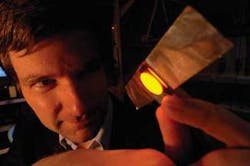Organic light-emitting diodes (OLED) have garnered much attention in recent years because of their potential to revolutionize lighting and displays. Now a team of researchers in Scotland has demonstrated in a pilot study that OLEDs may one day change the way photodynamic therapy (PDT) is used to treat skin cancer. In addition to the treatment of skin cancers, the researchers believe the technology could also be used in the cosmetic industry for anti-aging treatments or skin conditions such as acne.
Ifor Samuel, a physics professor at the University of St. Andrews (Fife, Scotland), and James Ferguson, head of the photobiology unit at Ninewells Hospital (Dundee, Scotland), have developed a lightweight, wearable OLED-based device—an optical bandage or patch of sorts—that is powered by a pocket-size battery about the size of an iPod.
Conventional therapies for nonmelanoma skin cancer (which accounts for about 80% of all skin cancers) involve either surgical removal or PDT. In the latter, the patient must go to the hospital or doctor’s office, where a photosensitizing cream (typically protoporphyrin and ALA) is applied to the affected area. After waiting about three hours for the photosensitizer to metabolize to the active form, red (580-640 nm) light is applied for 20 to 30 minutes. Most lesions take at least two such treatments. The light levels in the conventional approach can be high enough to cause pain.
“Our approach is stretched out over three hours, which solves the problem of pain and gives more time for oxygen to reach the site,” he notes. “With current office- and hospital-based approaches—versus our portable system—you couldn’t do this because the patient would have to sit in one place for too long and the hospitals need greater throughput.”
While the optical “sticking plaster,” as Samuel refers to it, has its foundations in his work with advanced displays and light-emitting dendrimers, it actually uses a much simpler and more readily available polymer OLED (on a glass substrate) as its light source. The light-emitting surface of the device is 2 cm in diameter—about the size of a typical skin-cancer lesion—and emits in the 590 to 630 nm range.
“Most other light sources are point sources,” says Samuel. “Even inorganic LEDs are close to being single-point light sources and thus would require a diffuser for this application, which would increase the thickness of the device.”
The patented technology was developed with support from Scottish Enterprise Proof of Concept funding and has been licensed to Lumicure, a spinoff established by Samuel and Ferguson that is in discussions with venture capitalists to raise equity funds to commercialize the product. From a commercial perspective, the market potential would appear to be quite large; roughly half of all Americans, for example, suffer from nonmelanoma skin cancer at some point in their lifetime. Lumicure is currently collaborating with Osram to develop the system for commercial production.
Kathy Kincade | Contributing Editor
Kathy Kincade is the founding editor of BioOptics World and a veteran reporter on optical technologies for biomedicine. She also served as the editor-in-chief of DrBicuspid.com, a web portal for dental professionals.
